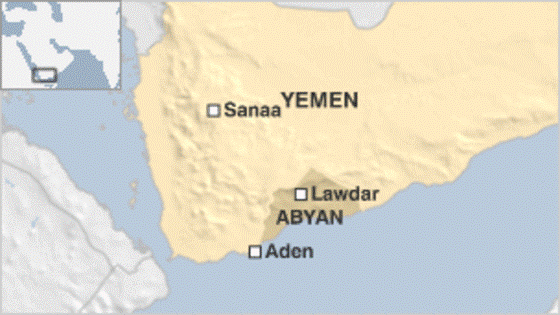Andrew McGregor
September 16, 2010
Heavy fighting between alleged al-Qaeda forces and government troops near the town of Lawdar in Yemen’s Abyan governorate broke out on the weekend of August 21-22 following a deadly ambush by AQAP fighters, claiming a reported eight to 11 soldiers and at least 14 militants (Reuters, August 22; Sep26.net, August 21; AFP August 22). Yemeni military forces were dispatched to the district to re-establish the government’s writ. Al-Qaeda militants and members of the secessionist Southern Mobility movement were given 24 hours to leave Lawdar or the houses they were staying in would be bombarded. Following a mass flight of civilians and the expiration of the ultimatum, more fighting broke out on August 22, as militants resisted their expulsion. Defense Minister General Muhammad Nasir Ahmad Ali was reported to be leading the security operations in Lawdar District personally (AFP, August 22).
Tribal mediation apparently failed in the conflict around Lawdar, with fatal consequences for one of those involved. A leader of the al-Fadl tribe, Shaykh Hussein Saleh Majdal, was assassinated along with his two bodyguards in an attack on the evening of September 4. The shaykh was described as leading the mediation between security forces and al-Qaeda militants (ArabNews.com, September 5; Yemen Observer, September 7).
Government sources have repeatedly referred to armed elements of the secessionist Southern Mobility movement as fighting alongside al-Qaeda in the struggle for Lawdar District. They described a plan by Southern Mobility leaders to assemble their followers in a march intended to break the security cordon around Lawdar (al-Watan, September 11). Security authorities also announced the detention of Muhammad Ahmad al-Mansub, an alleged “terrorist subversive element” who was arrested at a roadblock while in possession of documents alleged to detail the cooperation between AQAP and Southern Mobility (al-Siyasah [Kuwait], September 7). Southern Mobility, however, acknowledges it has activists in the region but says they are involved in “peaceful struggle” (Aden Press Online, September 12).
Although Deputy Interior Minister Saleh al-Zuari declared Lawdar District fully purged of “terrorist elements” on August 24, continuing operations revealed that the militant presence was far from vanquished. A day after al-Zuari’s statement, gunmen riding motorcycles targeted a military patrol in a public marketplace in the Zinjibar District of Abyan, killing four soldiers (Yemen Observer, August 28). On August 27, Yemeni troops took the worst of it in a clash with the militants near Lawdar, leaving 11 dead. Two militants were killed, including (according to security officials) the al-Qaeda second-in-command in Lawdar, Adel Saleh Hardaba (Yemen Observer, August 28).On the same day a 25 year-old al-Qaeda suspect was arrested in northern Abyan while on his way to Lawdar. He was found in possession of an explosives belt and told investigators he had been assigned by al-Qaeda commander Ali Alwi al-Saqqaf to carry out a suicide bombing in Lawdar (Yemen Observer, September 1).
Fighting erupted again on August 31 in which another 12 militants were reported killed. The alleged leader of al-Qaeda forces in the district, Salah Ali Abdullah Al-Damani, was arrested on September 5, though sources vary as to whether he was captured in a night-time raid or seized at a checkpoint (26Sep.net, September 5).
By September 7, AQAP fighters were reported to have largely, but not entirely, pulled out of Lawdar and were heading to nearby Ma’rib and Shabwah governorates, both current hotbeds of anti-government militancy. The director-general of Lawdar District, Ahmad Ahmad Ali al-Qafish, told journalists that the fighters included Saudi, Pakistani, Egyptian, Syrian and Somali elements, though this could not be confirmed (al-Siyasah [Kuwait], September 7). Defense Ministry sources reported three foreigners were discovered amongst the militants slain in the fighting of August 20-21 (26Sep.net, August 21).
This article first appeared in the September 16 2010 issue of the Jamestown Foundation’s Terrorism Monitor

